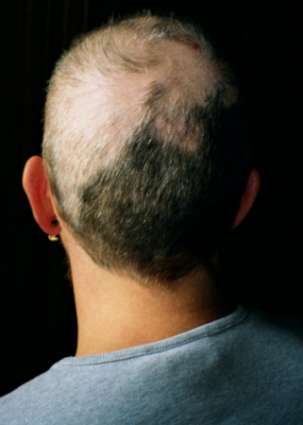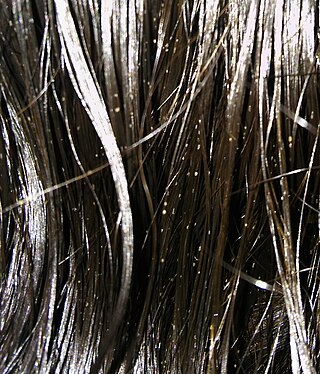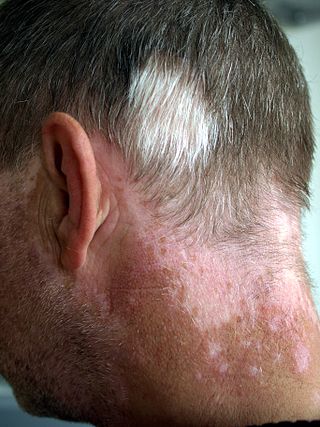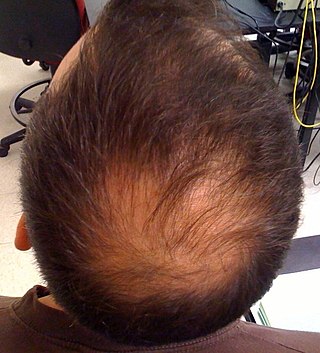
Trichotillomania (TTM), also known as hair-pulling disorder or compulsive hair pulling, is a mental disorder characterized by a long-term urge that results in the pulling out of one's own hair. A brief positive feeling may occur as hair is removed. Efforts to stop pulling hair typically fail. Hair removal may occur anywhere; however, the head and around the eyes are most common. The hair pulling is to such a degree that it results in distress and hair loss can be seen.

XY complete gonadal dysgenesis, also known as Swyer syndrome, is a type of defect hypogonadism in a person whose karyotype is 46,XY. Though they typically have normal vulvas, the person has underdeveloped gonads, fibrous tissue termed "streak gonads", and if left untreated, will not experience puberty. The cause is a lack or inactivation of an SRY gene which is responsible for sexual differentiation. Pregnancy is sometimes possible in Swyer syndrome with assisted reproductive technology. The phenotype is usually similar to Turner syndrome (45,X0) due to a lack of X inactivation. The typical medical treatment is hormone replacement therapy. The syndrome was named after Gerald Swyer, an endocrinologist based in London.

An eyelash is one of the hairs that grows at the edges of the top and bottom eyelids, spanning outwards and away from the eyes. The lashes grow in up to six layers on each of the upper and lower eyelids. Eyelashes serve to protect the eye from debris, dust, and small particles, and are highly sensitive to touch, thus providing a warning that an object is near the eye, which then reflexively closes or flutters to rid the area of the object. The eyelid margin from which lashes grow is among the most sensitive parts of the human body, with many nerve endings enveloping the roots of the lashes, giving it sensitivity to very light tactile input even at the tips of the lashes, enabling it to trigger the blink reflex when touched. Eyelashes are also an important component of physical attractiveness, with long prominent lashes giving the illusion of large, gazing eyes, and drawing attention to the eyes.

Lymphedema–distichiasis syndrome is a medical condition associated with the FOXC2 gene. People with this hereditary condition have a double row of eyelashes, which is called distichiasis, and a risk of swollen limbs due to problems in the lymphatic system.

Hay–Wells syndrome is one of at least 150 known types of ectodermal dysplasia. These disorders affect tissues that arise from the ectodermal germ layer, such as skin, hair, and nails.

White piedra is a mycosis of the hair caused by several species of fungi in the genus Trichosporon. It is characterized by soft nodules composed of yeast cells and arthroconidia that encompass hair shafts.

Pili torti is characterized by short and brittle hairs that appear flattened and twisted when viewed through a microscope.

Poliosis circumscripta, commonly referred to as a "white forelock," is a condition characterized by localized patches of white hair due to a reduction or absence of melanin in hair follicles. Although traditionally associated with the scalp, poliosis can affect any hairy area on the body, including eyebrows, eyelashes, and beards. Microscopically, poliosis is marked by the lack of melanin or melanocytes in the hair bulbs, though epidermal melanocytes typically remain unaffected unless associated with conditions like vitiligo.
Madarosis is a condition that results in the loss of eyelashes, and sometimes eyebrows. The term "madarosis" is derived from the ancient Greek "madaros", meaning "bald". It originally was a disease of only losing eyelashes but it currently is the loss of both eyelashes and eyebrows. Eyebrows and eyelashes are both important in the prevention of bacteria and other foreign objects from entering the eye. A majority of patients with madarosis have leprosy, and it was reported that 76% of patients with varying types of leprosy had madarosis.

Loose anagen syndrome, also known as loose anagen hair syndrome, is a hair disorder related to dermatology. It is characterised by the easy and pain free detachment of anagen staged hairs from the scalp. This hair condition can be spontaneous or genetically inherited.
The medical condition pseudopelade of Brocq is a flesh- to pink-colored, irregularly shaped alopecia that may begin in a moth-eaten pattern with eventual coalescence into larger patches of alopecia.
Anetoderma is a benign but uncommon disorder that causes localized areas of flaccid or herniated sac-like skin due to a focal reduction of dermal elastic tissue. Anetoderma is subclassified as primary anetoderma, secondary anetoderma, iatrogenic anetoderma of prematurity, congenital anetoderma, familial anetoderma, and drug-induced anetoderma.
Pressure alopecia, also known as postoperative alopecia, and pressure-induced alopecia, occurs in adults after prolonged pressure on the scalp during general anesthesia, with the head fixed in one position, and may also occur in chronically ill persons after prolonged bed rest in one position that causes persistent pressure on one part of the scalp, all likely due to pressure-induced ischemia.
Keratosis pilaris atropicans is a group of idiopathic genodermatoses that consists of three unique clinical entities: atrophoderma vermiculatum, keratosis follicularis spinulosa decalvans, and keratosis pilaris atrophicans faciei.
Trichostasis spinulosa is a common but rarely diagnosed disorder of the hair follicles that clinically gives the impression of blackheads, but the follicles are filled with funnel-shaped, horny plugs that are bundles of vellus hairs.
Graham-Little syndrome or Graham Little-Piccardi-Lassueur syndrome is a cutaneous condition characterized by lichen planus-like skin lesions. It is named after Ernest Graham-Little.

A pilar sheath acanthoma is a cutaneous condition most often found on the face, particularly above the upper lip in adults. Pilar sheath acanthoma is a skin-colored, 5-10 mm diameter papule or nodule with a keratin-filled pore in the center. Pilar sheath acanthoma diagnosis confirmed by shave or excisional biopsy. Successful treatment requires surgical excision.
Nevoid hypertrichosis is a cutaneous condition characterized by the growth of terminal hairs in a circumscribed area. Nevoid hypertrichosis often presents shortly after birth. The cause of nevoid hypertrichosis is unknown. The diagnosis is made based of clinical and histopathological examination.
Premature greying of hair (PGH), also known as canities, is the process of greying of hair occurring at an unusually early age. It can have negative effects on self-confidence, self-esteem, and social acceptance of the affected individual. Hair is said to have greyed prematurely if it occurs before the age of 20 years in Europeans, before 25 years in Asians, and before 30 years in Africans.
Frictional alopecia is the loss of hair that is caused by rubbing of the hair, follicles, or skin around the follicle. The most typical example of this is the loss of ankle hair among people who wear socks constantly for years. The hair may not grow back even years after the source of friction has ended.










